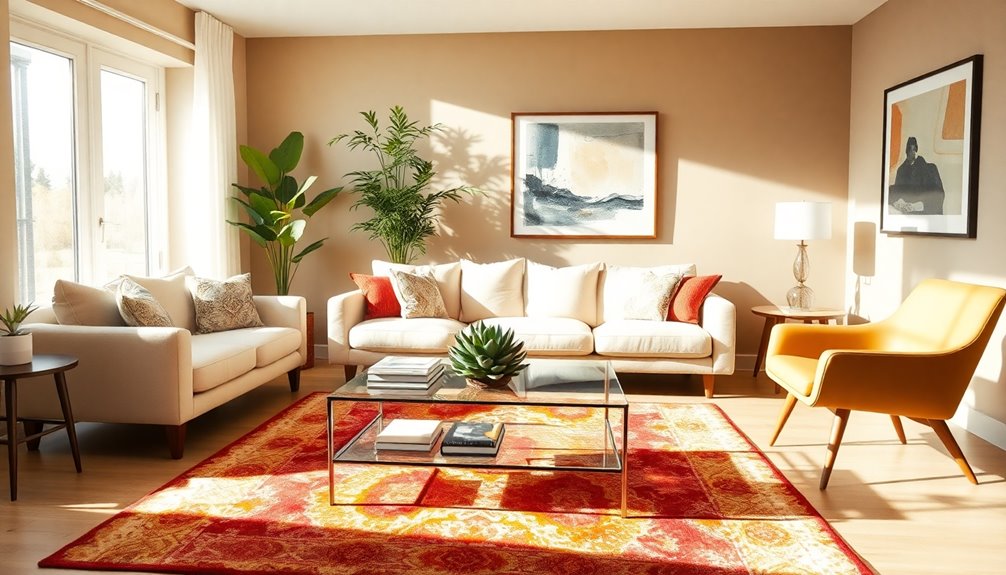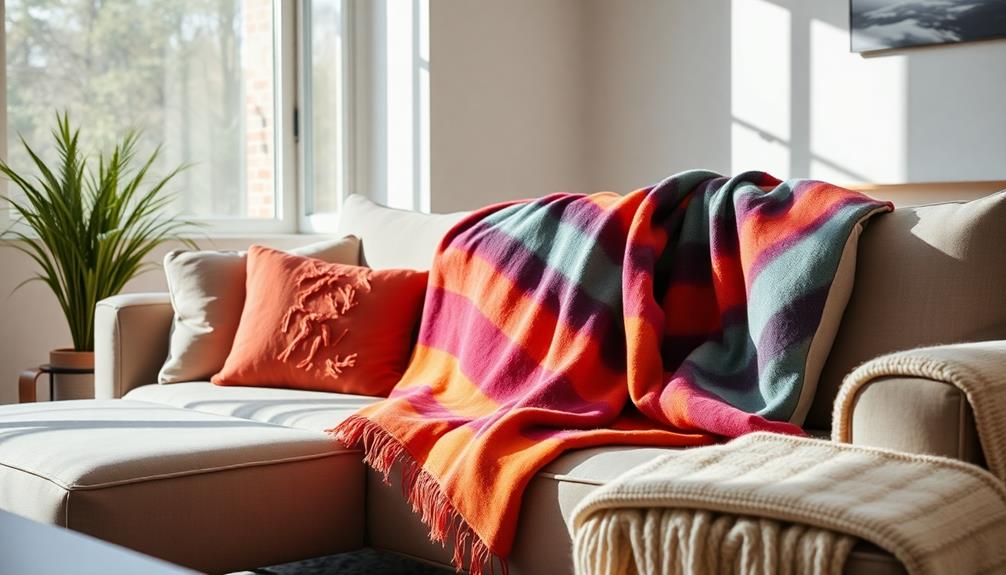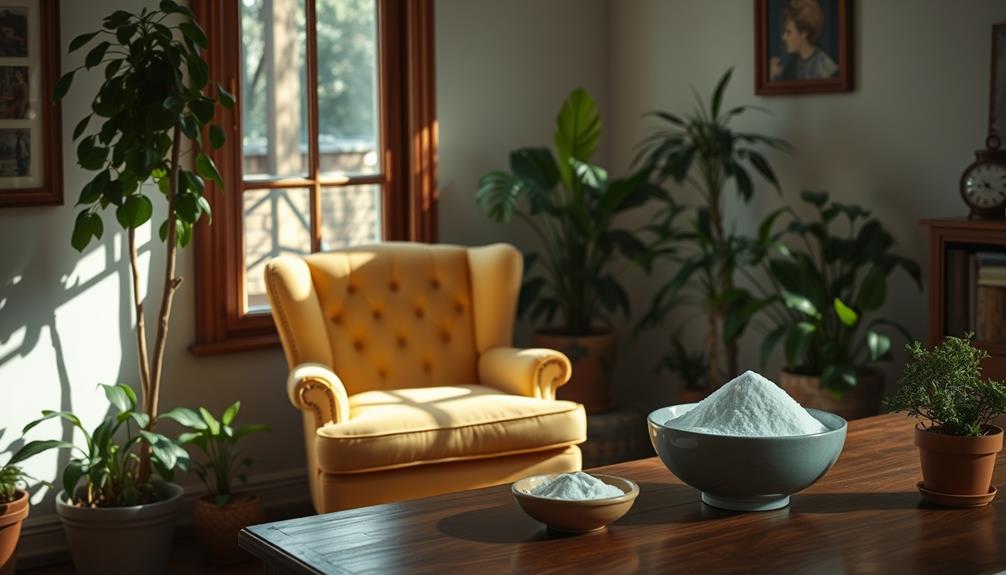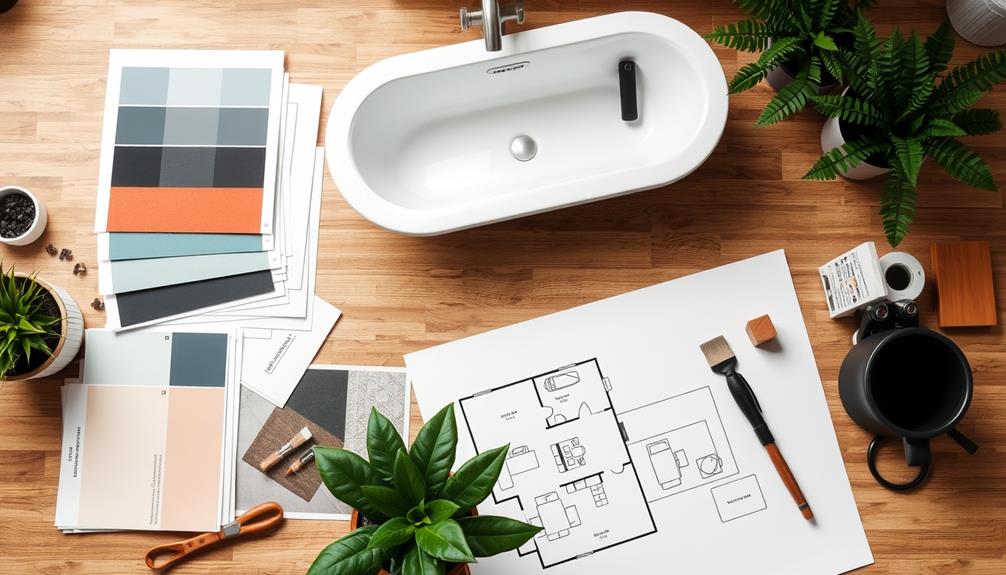To arrange furniture in your living room, start by choosing a focal point, like a fireplace or a piece of art. Position your largest pieces facing this focal point to create harmony. Balance the layout with either symmetrical designs for calm or asymmetrical for interest. Make sure to allow for traffic flow, keeping pathways clear and furniture well spaced. Create conversation areas by grouping seating around the focal point, ensuring comfort between pieces. For smaller rooms, use multifunctional furniture and pull pieces away from walls to define zones. You’ll discover more tips that can elevate your space even further. When considering the layout, it’s essential to think about practical aspects such as arranging furniture near baseboard heaters. Avoid placing large pieces directly in front of heaters to maintain proper airflow and ensure warmth throughout the room. Additionally, use rugs and other decor to delineate areas and enhance visual interest while ensuring that all safety measures are taken into account.
Key Takeaways
- Define a focal point in the room, such as a fireplace or artwork, to guide furniture placement.
- Create balance with symmetrical or asymmetrical arrangements to enhance visual interest and stability.
- Ensure clear traffic flow by maintaining wide pathways and avoiding large furniture near doors.
- Establish conversation areas by arranging seating to facilitate interaction around the focal point.
- Use area rugs to define zones in smaller or irregular rooms and enhance organization.
Choosing a Focal Point
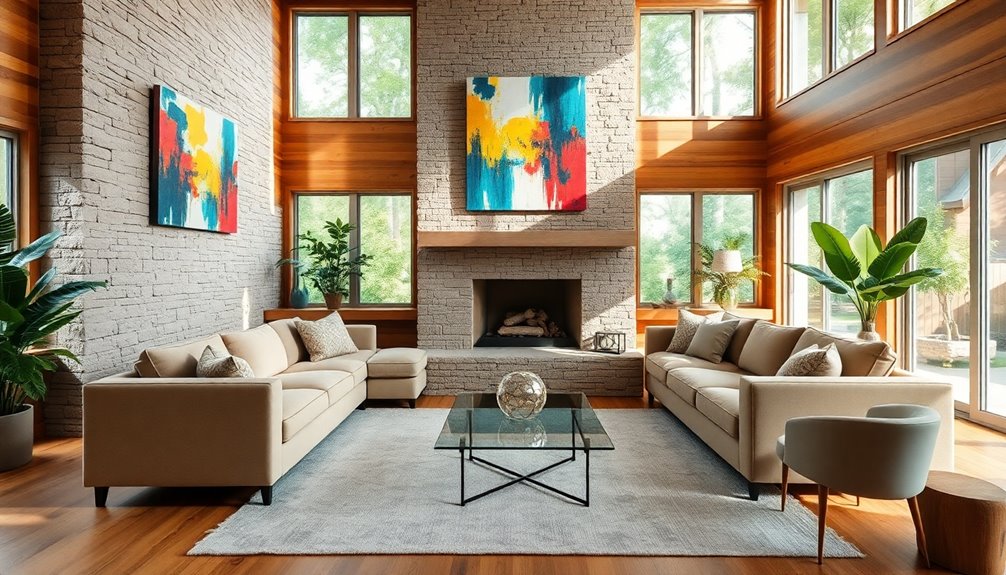
When arranging your living room, start by choosing a focal point that draws the eye and sets the tone for the space. This could be anything from a striking fireplace or large window to a captivating piece of artwork. Take a moment to consider any existing features, like a unique ceiling design or an accent wall, that may serve as an ideal focal point. Your chosen feature should reflect the room's style and be the first thing someone notices upon entering.
Once you've identified the focal point, position your largest furniture pieces, like sofas and chairs, directly facing it. This arrangement ensures that the furniture complements the focal point without competing for attention. You can then place smaller furniture pieces around the larger items, maintaining a natural flow throughout the room. Including warm and inviting elements can also enhance the overall appeal of the space.
To further enhance your focal point, incorporate decor that draws the eye in. This could include carefully selected artwork, decorative items, or even lighting fixtures that spotlight the area. Symmetrical arrangements on either side can add to the visual impact, making your focal point truly stand out.
Creating Balance
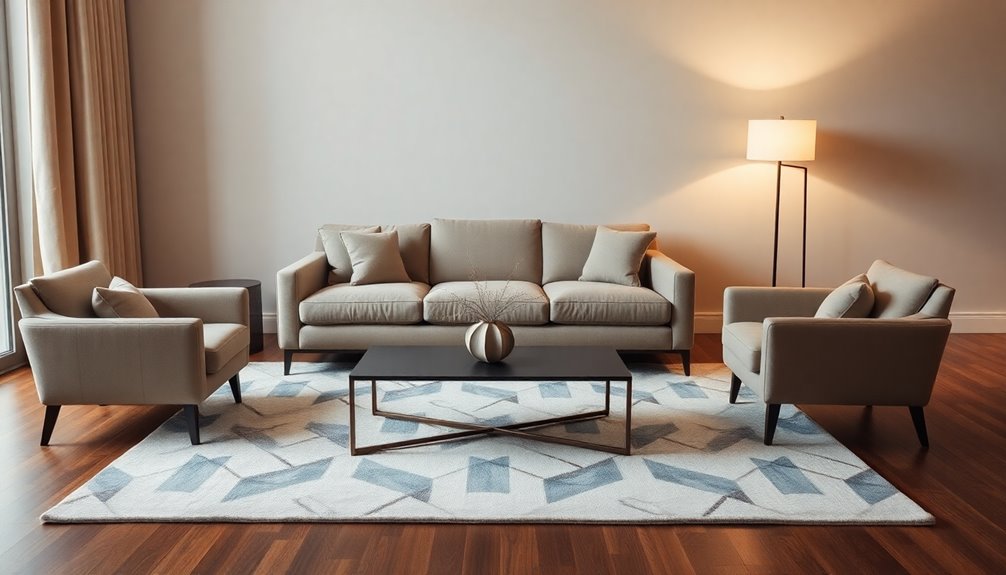
Arranging furniture in your living room isn't just about placing items around a focal point; it also involves achieving balance throughout the space. You can create balance using two main styles: symmetrical and asymmetrical. Symmetrical balance involves using an imaginary central line to create mirror images. For example, you might center a sofa on a wall with identical chairs on either side. This method provides stability and a calming atmosphere, especially when visual weight is balanced with similar elements.
On the other hand, asymmetrical balance introduces intentional contrasts. You can mix shapes and sizes, like placing a bold chair on one side to counterbalance a larger sofa on the other. To enhance visual interest, consider height—tall decor items like candlesticks can create intrigue without taking up floor space. Mastering asymmetry allows you to create visually engaging spaces that feel warm and inviting.
If your living room has an irregular layout, use furniture and rugs to define zones. Oversized statement pieces, like dramatic floor lamps, can anchor these areas. Remember, you don't need to match everything; mixing various sizes and heights will help maintain visual balance while adding character to your space.
Considering Traffic Flow
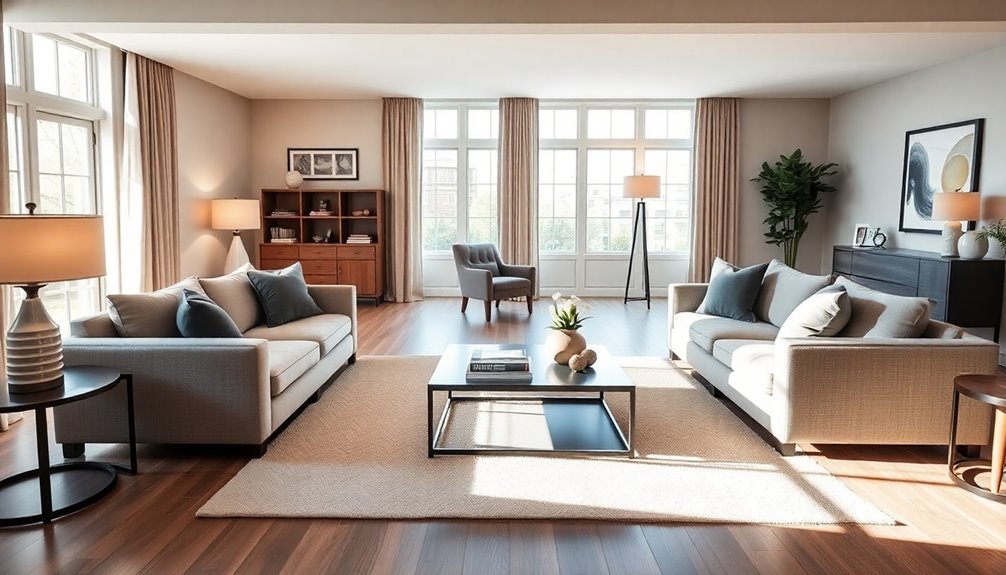
Traffic flow in your living room plays a crucial role in how comfortable and functional the space feels. To optimize this flow, start by identifying the natural paths of travel based on doors and openings. Ensure these pathways are clear and unobstructed, allowing for easy movement throughout the room. Pay attention to how people typically navigate the space, recognizing entry and exit points, focal points, and potential bottlenecks.
Maintain sufficiently wide pathways—at least 18 inches between sitting area furniture and 36 inches around dining tables—to accommodate foot traffic. Avoid forcing circulation through conversation or television watching areas, as this can disrupt the room's harmony. Be mindful of large furniture pieces; placing them near doors can create awkward bottlenecks. Additionally, consider the primary use of the living room to enhance traffic flow and functionality.
When grouping furniture, segment the room into functional zones while ensuring seamless navigation between them. Use multi-functional furniture to reduce clutter and enhance flow, and make sure doors can open and close freely. By anticipating and adjusting for natural traffic patterns, you can create a space that feels both inviting and practical, allowing everyone to move comfortably throughout your living room.
Conversation Areas
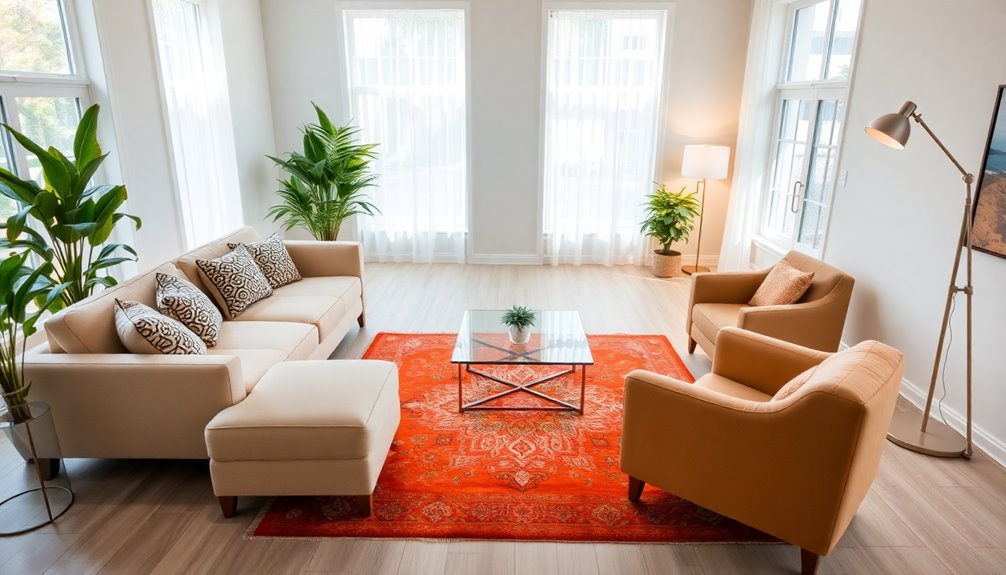
Creating inviting conversation areas in your living room starts with identifying a focal point, such as a fireplace or television, and arranging furniture to enhance interaction. Aim for a conversation circle with a diameter of 7 to 10 feet to encourage easy communication. Begin by placing your main seating piece, like the sofa, first, then arrange complementary furniture around it.
A versatile setup is a sofa with a pair of chairs facing each other, while angled chairs can add visual interest. If you have a larger space, consider two sofas facing each other for a formal look, or a 'U' shape with a sofa, loveseat, and chairs for larger gatherings. Maintain 1 to 2 inches between furniture for comfort, and ensure at least 18 inches between the coffee table and sofa for easy movement. Optimal interaction in conversation zones is achieved when furniture pieces are within the designated circular area.
Use area rugs to frame your conversation area, ensuring all furniture pieces sit on the rug. Enhance the space with decorative elements like plants and lamps, and pay attention to the scale of your furniture to maintain balance. Creating symmetry and incorporating different textures will help you achieve a warm and inviting atmosphere.
Arranging Small or Irregular Rooms
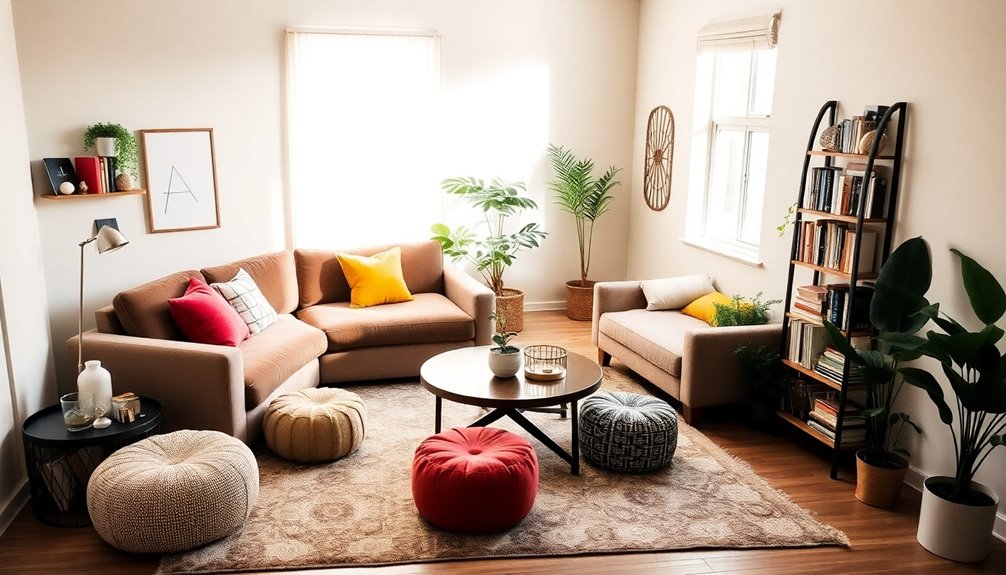
When dealing with small or irregular rooms, it's essential to make the most of the available space. Start by establishing a focal point, whether it's a fireplace, TV, or even a large window. If there's no natural focal point, create one with a bold piece of furniture or artwork. Arrange your seating to face this focal point, enhancing visual appeal and fostering a cohesive atmosphere. Use lighting strategically to highlight it.
Next, create distinct zones within the room. Divide the space into functional areas like a seating area, reading nook, or workspace by using area rugs and well-placed furniture. Invest in multifunctional pieces, like a storage ottoman, to keep things organized and clutter-free. Utilizing vertical space effectively can also enhance the room's functionality and openness.
Maximize vertical space by installing tall bookshelves or wall-mounted shelves to keep the floor area open. Hang curtains close to the ceiling to create an illusion of height.
Finally, optimize furniture placement by pulling pieces away from the walls to create defined living areas. Maintain clear paths for traffic flow and consider a symmetrical layout to promote order. Compact furniture and rounded arrangements can also help save space and enhance movement.
Frequently Asked Questions
What Style of Furniture Should I Choose for My Living Room?
When choosing furniture for your living room, consider your personal style first. If you love a modern vibe, opt for velvet sofas and natural wood accents. For an industrial look, think exposed bricks and a black sofa. If eclectic suits you, mix textures and bold colors. Mid-century fans should seek wooden legged furniture and neutrals. Each style can bring a unique atmosphere, so pick what resonates with you and enhances your space!
How Do I Incorporate Personal Items Into My Furniture Arrangement?
To incorporate personal items into your space, start by selecting decor that reflects your style, like unique throw pillows or vibrant artwork. Use plants for a fresh touch and personal collectibles as standout pieces. Balance these accents to avoid clutter; remember, less is often more. Create distinct areas with rugs or floor pillows to define zones. Ultimately, let your personality shine through while ensuring the arrangement remains functional and inviting.
Should I Match Furniture Styles or Mix Them?
When deciding whether to match or mix furniture styles, think about your personal taste. If you prefer a cohesive look, matching styles creates a uniform aesthetic and simplifies coordination. On the other hand, mixing styles can showcase your unique personality and add visual interest. To achieve balance, consider using a consistent color palette or unifying elements. Ultimately, it's about what resonates with you and makes your space feel inviting and comfortable.
How Can I Incorporate Technology Like Speakers or Gaming Systems?
To incorporate technology like speakers or gaming systems, you'll want to think about placement and accessibility. Position your speakers symmetrically along the longest wall for optimal sound. For gaming, centralize your console and ensure seating allows for social interaction. Use cable management to keep things tidy. Additionally, look for furniture with built-in charging options and smart features to blend tech seamlessly into your space, enhancing both functionality and aesthetics.
What Are Some Budget-Friendly Furniture Arrangement Tips?
When it comes to budget-friendly furniture arrangement, start by measuring your space to ensure everything fits. Use what you already have—rearranging can make a big difference without spending a dime. Consider creating cozy conversation areas and maintaining clear pathways for traffic flow. Swap items between rooms for a fresh look, and use creative storage solutions like baskets or multifunctional furniture to keep things organized and visually appealing without breaking the bank.
Conclusion
Now that you know how to arrange your living room furniture, take a moment to visualize your space. Remember to choose a focal point, create balance, and consider traffic flow for a welcoming atmosphere. Don't forget to arrange areas for conversation, ensuring everyone feels included. If you're working with a small or irregular room, get creative with your layout. With these tips, you can transform your living room into a cozy and functional gathering space. Happy decorating!
